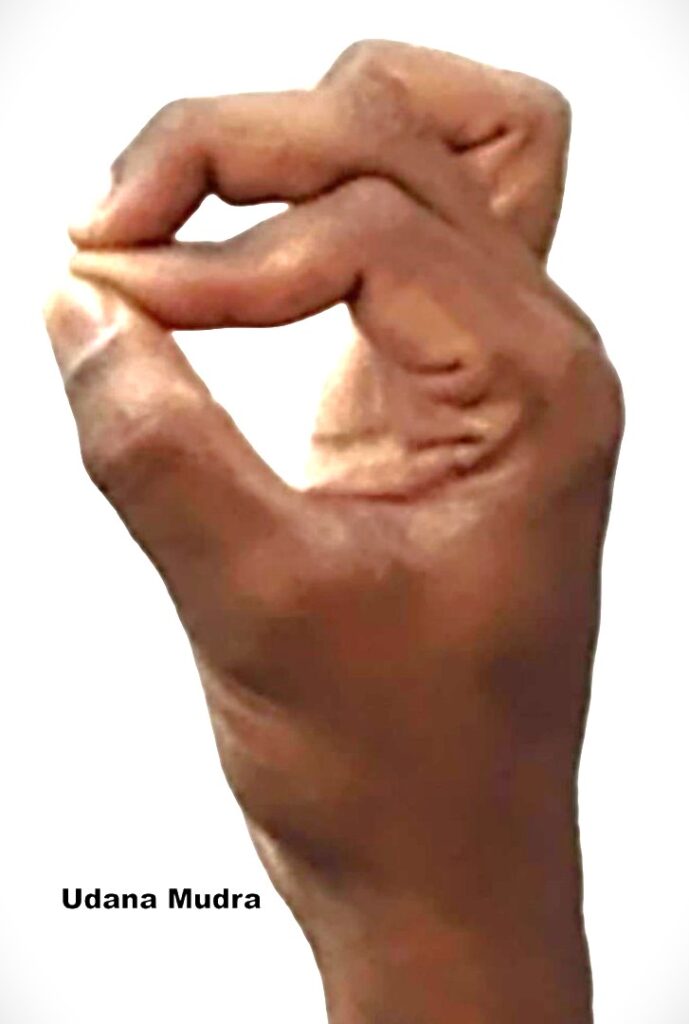Udana Mudra
Introduction
Udana Mudra is a hand gesture in yoga that helps boost energy, improve vitality, and enhance upward flow of prana (life force). It is particularly used to stimulate the throat and head regions, supporting communication, mental clarity, and spiritual growth.
The term Udana in Sanskrit means “upward moving energy”, reflecting the mudra’s role in channeling energy from the body upward, aiding in expression, inspiration, and vitality. It is often recommended in yogic therapy, meditation, and pranayama practices.
Meaning
Udana: Upward moving energy, vitality, inspiration.
Mudra: Hand gesture used to direct prana and energy flow.
Overall Meaning:
Udana Mudra facilitates the upward movement of energy, enhancing vitality, mental clarity, communication, and spiritual awareness.
How to Perform / Practice
Come into a sitting position or practice while walking.
Using both hands, join the tips of your thumbs and index fingers.
Place the tips of your middle fingers on the nails of the index fingers and apply gentle pressure.
Allow your ring and little fingers to remain slightly curled, but relaxed.
Practice for 15–30 minutes daily, or 5–10 minutes in short intervals.
Tip: Best practiced in the morning to stimulate energy or during meditation for clarity and focus.
Benefits
Physical Benefits:
Improves energy levels and reduces fatigue.
Enhances respiratory and circulatory functions.
Supports throat, neck, and head regions.
Boosts immunity and overall vitality.
Mental & Emotional Benefits:
Improves concentration, mental clarity, and focus.
Reduces lethargy, mental fatigue, and emotional stress.
Encourages positive thinking and emotional stability.
Energetic / Spiritual Benefits:
Stimulates upward flow of prana, promoting spiritual awareness.
Activates the throat chakra (Vishuddha) and third eye chakra indirectly.
Supports meditation and energy practices aimed at mental and spiritual growth.
Contraindications
Avoid if experiencing hand or finger injuries.
Not recommended for severe hypertension or insomnia without guidance.
Stop practice if numbness, tingling, or discomfort occurs.
Anatomy & Physiology
Muscles: Intrinsic hand muscles (lumbricals, interossei) maintain finger positions; forearm muscles stabilize the hand.
Joints: Flexion at middle and ring fingers; extension at index and little fingers.
Nervous System: Activates parasympathetic system while also enhancing alertness and upward energy flow.
Circulation: Improves microcirculation in hands and fingers, indirectly stimulating energy flow.
Kinesiology
Enhances fine motor control and finger coordination.
Improves neuromuscular communication between hand and brain.
Supports static posture stability during meditation.
Neurology
Stimulates brain regions related to alertness, focus, and energy regulation.
Encourages parasympathetic and sympathetic balance, reducing mental fatigue while enhancing vitality.
Supports neural plasticity, improving mental clarity, memory, and communication skills.
Duration of Practice
Daily Practice: 15–30 minutes, can be divided into 2–3 sessions.
Short Practice: 5–10 minutes during meditation or work breaks.
Can be combined with pranayama, visualization, or other mudras for enhanced effect.
Counter Mudra
If excess energy or restlessness occurs, switch to Gyan Mudra or Chala Mudra.
Gentle hand stretching or shaking helps release tension after practice.
Conclusion
Udana Mudra is a simple yet effective gesture to enhance energy, mental clarity, and spiritual awareness. Regular practice harmonizes upward flow of energy, strengthens body and mind, and supports meditation and vitality. Proper execution ensures maximum benefits without discomfort.
FAQ
Q1: Can beginners practice Udana Mudra?
A: Yes, it is safe and simple. Start with 5–10 minutes and gradually increase.
Q2: Can it help with energy and focus?
A: Yes, it stimulates upward flow of prana, improving alertness and mental clarity.
Q3: Can it be combined with other mudras?
A: Yes, often combined with Dhyana Mudra, Gyan Mudra, or Prana Mudra.
Q4: Is it suitable for spiritual meditation?
A: Yes, it enhances upward energy flow, supporting meditation and spiritual practices.
References
Swami Satyananda Saraswati, Mudras for Healing and Transformation.
Iyengar, B.K.S., Light on Yoga.
Saraswati, S., Pranayama and Mudras in Yoga Therapy.
Fishman, L., Yoga for Emotional Balance.
Journal of Bodywork and Movement Therapies, 2018; 22(4): Effects of Hand Mudras on Mental and Physiological Functions.

